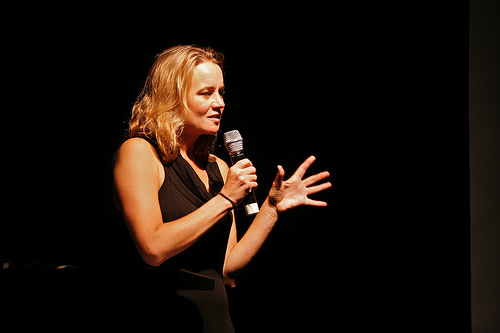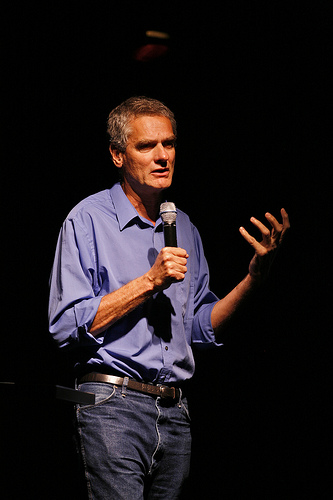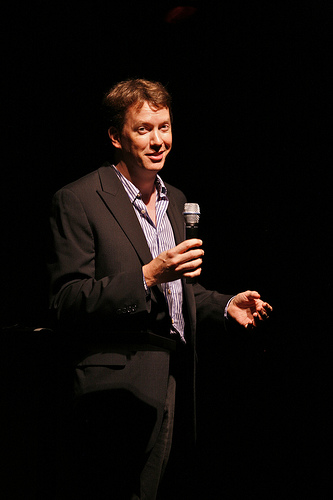The 2009 World Science Festival kicked off its third day of festivities on Friday with a truly original and delightful event called WSF Spotlight, which stripped away the trimmings of what you might think of as “traditional” science presentations (flat lighting? a vast echoey lecture hall? dry droning delivery?), and replaced them with a dramatically lit, intimate, cabaret-style setting — the 92nd Street Y’s new location in Tribeca on Hudson Street.
Cocktails were served as the crowd took seats at the tables along the stage, giving the setting the feel of a late-night comedy club or open-mic night. And the “performers” were easily as entertaining.
It was such a treat, first of all, that frequent TEDster and philosopher-comic-writer-trickster Emily Levine was the night’s MC. She was her usual self: witty, hilarious and slightly (just slightly?) provocative. She was the perfect primer for the challenging marinade of ideas we were about to sink into — providing context and shaping some of the more complex background ideas into a palatable form by drawing analogies between them and her own observations of everyday life — in particular the way that recognition and acceptance of a contradiction can be one of the most wondrous experiences. Then there was this: “Will people like science better if we ply them with liquor?” Yes, probably.
We first heard from Dominic Johnson, a scientist in both evolutionary biology and political science. His dual background may have seemed a contradiction at first, but he showed that the two fields can be strongly related. He hopes that evolutionary-based lessons from nature can help us improve human security as it pertains to threats like climate change and terrorism. With our planet cradling somewhere between 10 and 100 million species, each with their own solutions to the unique life-threatening problems endemic to their habitat, Johnson suspects that many organisms may have solutions that map onto the sorts of threats to human safety today’s governments face. Just as improvised explosive devices (IEDs) represent an “evolving strategy” on the part of terrorists to injure governments and societies, we might consider our own society/government a sort of organism that must develop adaptations on the fly in order to meet those threats.

Kristin Baldwin‘s dry humor was the highlight of the night for many of us. (She noted that her lab students who grew up playing video games tend to be the best at completing some of the lab procedures, such as inserting nuclei into host egg cells with a sort of microscopic syringe called a pipette.) She showed how contentious issues such as cloning and stem cell research are not nearly as simple as the mainstream media — and science fiction — make them out to be — nor are they quite as ethically problematic as some would claim. Baldwin, who wants to use stem cell technology and genetic engineering to understand the brain and neurological diseases, used clips from films such as Woody Allen’s Sleeper and Harold Ramis’ Multiplicity (with Michael Keaton) to show what depictions of cloning have gotten right about the real science, and also how they diverge from it.
 Christopher McKay talked about his search for a “second genesis” somewhere in our solar system, and the captivating notion that if life began twice in a single solar system, then there would be a high possibility that our universe is teeming with life. McKay, a research scientist at NASA’s Ames Research Center, covered some of the more tantalizing possibilities for the discovery of life on other planets, including our best bet, Mars, and also moons of the outer gas-giant planets like Titan and Enceladus. He noted that the molecules that build living organisms tend to exhibit a certain chirality, or “handedness,” and that searching for samples of molecules that are completely left-handed (rather than a mix of right and left) would be a powerful indicator of biological processes taking place. He also shared plans for a new Mars mission that would dig four meters into the Martian crust in search of evidence of life.
Christopher McKay talked about his search for a “second genesis” somewhere in our solar system, and the captivating notion that if life began twice in a single solar system, then there would be a high possibility that our universe is teeming with life. McKay, a research scientist at NASA’s Ames Research Center, covered some of the more tantalizing possibilities for the discovery of life on other planets, including our best bet, Mars, and also moons of the outer gas-giant planets like Titan and Enceladus. He noted that the molecules that build living organisms tend to exhibit a certain chirality, or “handedness,” and that searching for samples of molecules that are completely left-handed (rather than a mix of right and left) would be a powerful indicator of biological processes taking place. He also shared plans for a new Mars mission that would dig four meters into the Martian crust in search of evidence of life.
 Sean Carroll, a Senior Research Associate at Caltech who studies cosmology and the so-called “arrow of time,” proved to be a crowd favorite with his simple, memorable explanations of exceedingly complex scientific concepts such as entropy and the second law of thermodynamics. (I think he deserves the “great science communicator” badge that is also donned by the likes of Marcus du Sautoy and Bonnie Bassler.) He began with the observation that time is an intrinsic part of our daily lives, but it is extremely difficult to say what time actually is. Unlike space, which has no direction, time apparently does have a direction, and that direction is defined by the law that says disorder can only increase in a closed system (such as a universe). In other words, it is easier to make a scrambled egg from a whole egg than to make a whole egg out of scrambled egg. His own conclusion? This fact — “You’re more likely to find a scrambled egg floating in space than a whole, unbroken egg” — is our best evidence for the possibility that we actually inhabit a multiverse — our universe is only one of many, or one small part of a larger one.
Sean Carroll, a Senior Research Associate at Caltech who studies cosmology and the so-called “arrow of time,” proved to be a crowd favorite with his simple, memorable explanations of exceedingly complex scientific concepts such as entropy and the second law of thermodynamics. (I think he deserves the “great science communicator” badge that is also donned by the likes of Marcus du Sautoy and Bonnie Bassler.) He began with the observation that time is an intrinsic part of our daily lives, but it is extremely difficult to say what time actually is. Unlike space, which has no direction, time apparently does have a direction, and that direction is defined by the law that says disorder can only increase in a closed system (such as a universe). In other words, it is easier to make a scrambled egg from a whole egg than to make a whole egg out of scrambled egg. His own conclusion? This fact — “You’re more likely to find a scrambled egg floating in space than a whole, unbroken egg” — is our best evidence for the possibility that we actually inhabit a multiverse — our universe is only one of many, or one small part of a larger one.
The grand finale was physicist and Nobel Prize-winner Frank Wilczek, who told a funny, three-part story of quantum physics, as illustrated by the Schrödinger’s cat thought experiment. “Why would we want to hurt a cat,” he started, “and how might we go about doing so?” He used the interesting properties of subatomic particles to segue into a discussion about a new type of composite particle made out of “cunningly arranged components” that might be useful to research in quantum computing — because these particles only seem to be effected by the same type of particle. And finally, he surprised and delighted the crowd by suddenly calling a keyboardist to the stage and performing a seven-minute ditty called “No Wandering Atom I,” a song of an atom that falls in love with a human female.
Comments (1)